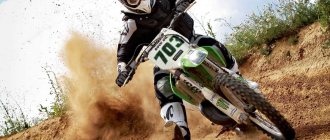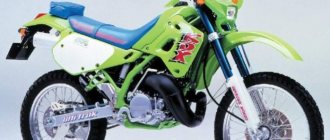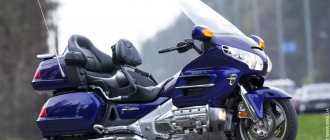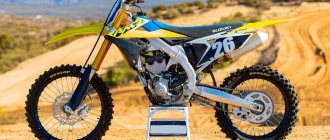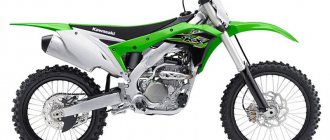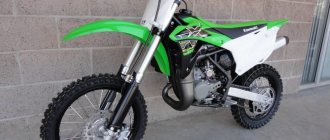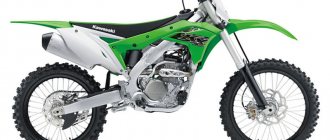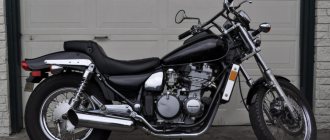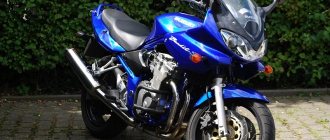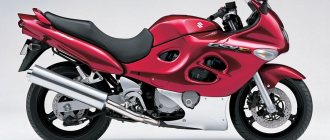- Kawasaki motorcycle model
The Kawasaki KLE 500 touring enduro model appeared in 1991 and was aimed at the European market. A 400 cc version was built for the domestic Japanese market - the Kawasaki KLE 400. In 2005, the Kawasaki KLE 500 underwent a slight restyling, which affected the design of the front of the motorcycle, the dashboard and the exhaust system (to comply with the new Euro environmental standards). 2007 was the last year of production of the model, which was replaced by the Kawasaki Versys 650.
The Kawasaki KLE 500 was based on the engine from the sports Kawasaki GPZ500, which was retuned and derated to increase torque in the low and medium speed zone. The engine itself is an in-line 2-cylinder liquid-cooled unit with a volume of about 500 cc. see, producing 48 hp. power and 42 Nm of torque. Since 2005 and the introduction of updated environmental standards, the engine began to produce 45 hp. power and 41 Nm of torque. Despite Kawasaki's attempts to make the engine high-torque, it has not lost its sporting roots, showing maximum performance at fairly high speeds - 7500-8500 rpm.
The chassis of the Kawasaki KLE 500 is presented in the form of a simple tubular frame, long-travel suspension in the form of a conventional telescopic fork at the front and a progressive monoshock absorber at the rear, and spoked wheels measuring 21′ and 17′.
Other features of the motorcycle include a 15-liter fuel tank, a 6-speed gearbox and 181 kg of dry weight.
000_moto_0911_048
Kawasaki KLE500: touring enduro, 1991–2006, 498 cm³, 192 kg, RUB 80,000–200,000.
Kawasaki KLE500: touring enduro, 1991–2006, 498 cm³, 192 kg, RUB 80,000–200,000.
STORY. On the growing wave of popularity of touring enduros, at the very beginning of the 90s, Kawasaki also released its mid-size SUV.
Unlike most competitors who used traditional recipes, the company took an unusual path. The “stove” from which engineers and marketers danced was the well-proven two-cylinder 500 cc in-line engine from the GPZ500 Ninja sportbike. The engine turned out to be so versatile that in addition to enduro and sports, it was even used on the EN500 Vulcan chopper. For KLE it was derated from 60 hp. at 9800 rpm up to 50 hp. at 8500, while managing to practically not lose at the peak of torque: from 46 Nm at 8500 rpm for the GPZ to 45 Nm at 6500 rpm. At the same time, the character of the engine remained quite sportbike: the engine loves high speeds (the red zone starts at 11,000 rpm) and reveals its potential only in the second half of the tachometer, which determines its asphalt orientation. Of course, along with the European version in Japan, it entered the market, “shrinked” to 400 cm³ and 42 hp. option. The motorcycle was not supplied to the USA. The device was produced virtually unchanged for fifteen years, and only in 2005 it underwent a slight facelift. The filling remains the same. The history of KLE ends in 2007, when the “old man” was replaced by a completely new KLE650, better known as Versys.
Dimensions and weight
In terms of dimensions, this machine is designed for a person from 170 cm tall. However, sometimes shorter people also operate such a machine. If a person is a beginner and his height is below the specified height, it is better to choose something else.
If this is an experienced enduro driver, then everything is individual, because a lot depends on skill. However, an experienced driver is unlikely to decide to take risks and will choose a bike that is suitable for himself.
The dimensions are as follows:
- height – 1270 mm;
- width – 880 mm;
- length – 2215 mm;
- wheelbase – 1500 mm;
- seat height – 850 mm;
- ground clearance - 200 mm;
- curb weight – 200 kg;
- Tank capacity – 15 l.
These dimensions make the car an average touring enduro. Low ground clearance is a noticeable disadvantage, because it makes the equipment unsuitable for off-road use. Perhaps Kawasaki believed that in this case you wouldn’t have to raise your legs so high, which means it would be more comfortable to ride for a long time.
003_moto_0911_048
2007 Kawasaki Versys.
Versys (from versatile system - multi-purpose system) developed and continued the theme of a comfortable city motorcycle with slightly increased cross-country ability. 2007 Kawasaki Versys. Versys (from versatile system - multi-purpose system) developed and continued the theme of a comfortable city motorcycle with slightly increased cross-country ability.
FOR WHAT? Of course, there is no need to talk about the KLE as a full-fledged enduro. A “torque” engine, coupled with a fairly high seating position, long-travel suspensions, a narrow “body” and low weight - the KLE turned out to be an almost ideal city motorcycle, capable of confidently staying in traffic and, if necessary, storming all kinds of city obstacles. Of course, with such characteristics, the motorcycle also had good potential in asphalt tourism. The relative weakness of the chassis and the abundance of plastic parts and the same road character of the engine did not allow the KLE to become a star of rally raids or a tool for traveling around the world, but it occupied its niche for many years, becoming practically the first full-fledged crossover in the world of motorcycles. Even here in Russia, which is distinguished by its special love for the inappropriate use of motorcycles, the “kleha” is not considered a full-fledged competitor either to the Honda Transalp or to all sorts of “single-barrel” models of similar capacity like the Yamaha Ténéré 660. At its core, the KLE is much closer to the Yamaha TDM, although is in a different weight category and has a little more off-road potential due to the spoked wheels of a traditional off-road size. Nevertheless, the device is not bad as a medium-range tourist. It is not afraid of broken roads and dirt roads, but the motorcycle is quite demanding on the quality of gasoline. The engine noticeably deteriorates if it is “fed” with 92, so it’s better not to go into the “bear corners” where, except for the “eightie”, there has never been any other gasoline. City life, trips to the country and vacations at the seaside - this is his habitat.
WHERE TO LOOK? Due to its “under-endurance” and “under-cubature”, KLE did not receive the same deafening popularity and mass popularity as the same “transalp”. Nevertheless, in second-hand stores, motorcycles are regularly found, but more often in a single copy, so choosing a device even from a couple of three is problematic. “Europeans” and “Japanese”, that is, “five hundred” and “four hundred”, are found in approximately equal proportions, while the price of “full-power” and “scabies” is practically the same - the difference in power and cubic capacity is too small.
It makes sense to choose a device based on private advertisements. KLE is rarely purchased as a first motorcycle, and it almost never falls into the category of “pontobikes” that are used “for all the money”. As a rule, a “klekha” is bought as a trial medium enduro, and later either switches to more off-road equipment, or to more powerful representatives of the breed.
WHAT TO WATCH FIRST AND WHAT TO FOLLOW LATER?
«+» Engine and transmission. The engine, which has been in production for almost twenty years, is very reliable and durable, even the copies of the first years of production do not “eat” oil. The only thing is that he needs good gasoline with O.C. no lower than 95 - sportbike roots make themselves felt.
«!» Brakes. The front single-disc brake with a two-piston caliper does not look very impressive by modern standards, and its efficiency is clearly not enough for a fairly powerful car. This becomes especially noticeable when driving with a passenger. The reason for this is not a design flaw, but the antiquity of the design. At the time of development of the device, the requirements for brake performance were not at all the same as now, although in general their effectiveness is quite sufficient for safe movement. The rear brake mechanism, on the contrary, is too tenacious. A wheel skidding when braking occurs quite early and unpredictably. You just need to get used to this feature of the motorcycle and learn to use the rear brake more carefully.
«-» Timing belt Often on motorcycles with high mileage, the timing chain begins to make noise. If the defect is present, the motorcycle has traveled at least 50–60 thousand km. If, however, the odometer shows 25–30 thousand km, this only means that the device readings were adjusted before the sale, and this is a serious reason for bargaining. The defect is treated by manually tightening the automatic chain tensioner, which sometimes does not have enough spring force to push the stop pin one more click. Timing chain noise itself is not a critical defect. You can travel with it for quite a long time. The service manual does not regulate the replacement of the chain at all, so it is designed for the entire service life of the motorcycle, that is, at least 100 thousand km.
«!» Suspension. The front fork has no mechanical adjustments, but is equipped with nipples for pumping air. When choosing a device, you should check the air pressure in the feathers. It should be within 1.5–2.5 atmospheres. Without pressure, the fork will, firstly, be too soft, and secondly, its performance will be inadequate. Even with maximum air pressure, the fork may still feel too soft for some people. In this case, you can try pouring a more viscous oil into the feathers. The rear shock absorber is equipped with spring preload and rebound hydraulic adjustments. The unit is quite durable and even after many years of use it rarely leaks.
«+» Wind protection. The stock windshield does not do its job well, especially if the pilot’s height exceeds 175 cm. In the urban riding cycle this is not so important, but if the motorcycle is bought for travel, a touring windshield will be a big plus. In aftermarket catalogs, this part is vanishingly rare and at a very low-budget price.
What do the owners say?
Almost every review notes that the car handles like an A+. Turning is easy and comfortable, at least on the road. According to the description of those who purposefully tested the bike on rough terrain, the ride is spoiled by the ground clearance. Plus, these people point out that it's not the most reliable car for this.
Even if you buy a good used bike, it is unlikely to be almost like new. Still, this is a touring enduro, which means it has been actively used and has significant mileage. They note, however, that today it is inexpensive to buy such a motorcycle. About 120 thousand Russian rubles - that’s how much such a model costs.
Those who have driven a sportbike before say that this machine is radically different in its handling style. And it was as if they were learning to drive again, although this, of course, is an exaggeration. But the difference is huge, and we should not forget about it. Professionals who have ridden motocross motorcycles say that the difference is immediately visible. This touring enduro makes you feel the weight of the machine even more than other classmates.
In conclusion, it is worth noting that the Kawasaki KLE 500 is good for different conditions. However, this is primarily a vehicle for roads, not rough terrain. The machine is able to cope with this, but you should not abuse this opportunity, so as not to run into problems in the wild.
008_moto_0911_048
Tidying up the “klekha” is also simple to the point of asceticism.
And the red zone of the tachometer, starting at 11,000 rpm, indicates that this is a “four hundred”; in the half-liter version, the red zone begins a little earlier. Tidying up the “klekha” is also simple to the point of asceticism. And the red zone of the tachometer, starting at 11,000 rpm, indicates that this is a “four hundred”; in the half-liter version, the red zone begins a little earlier.
Brief history of the model
1987 - the beginning of the official release and sales of the Kawasaki GPZ 500 S. Model: Kawasaki EX500 (North America), Kawasaki GPZ500 (Europe). Factory designation: EX500-A1
1988 - no significant changes. Model: Kawasaki EX500 (North America), Kawasaki GPZ500 / GPZ500S (Europe). Factory designation: EX500-A2, EX500-B1
1989 - no significant changes. Model: Kawasaki EX500 (North America), Kawasaki GPZ500 / GPZ500S (Europe). Factory designation: EX500-A3, EX500-B2
1990 - no significant changes. Model: Kawasaki EX500 (North America), Kawasaki GPZ500 / GPZ500S (Europe). Factory designation: EX500-A4, EX500-B3
1991 - no significant changes. Model: Kawasaki EX500 (North America), Kawasaki GPZ500 / GPZ500S (Europe). Factory designation: EX500-A5, EX500-B4
1992 - no significant changes. Model: Kawasaki EX500 (North America), Kawasaki GPZ500 / GPZ500S (Europe). Factory designation: EX500-A6, EX500-B5, EX500-C1
1993 - no significant changes. Model: Kawasaki EX500 (North America), Kawasaki GPZ500 / GPZ500S (Europe). Factory designation: EX500-A7, EX500-B6
1994 - the Kawasaki GPZ 500 model undergoes minor changes - in particular, the wheels become 17-inch (instead of 16′), the rear drum brake is replaced with a disc brake, the old generator is replaced with a more advanced one. In addition, changes also affected the appearance, namely, the front fairing, headlights, mirrors, dashboard, etc. Model: Kawasaki Ninja 500 (North America), Kawasaki GPZ500S (Europe). Factory designation: EX500-D1, EX500-E1, EX500-F1
1995 - no significant changes. Model: Kawasaki Ninja 500 (North America), Kawasaki GPZ500S (Europe). Factory designation: EX500-D2, EX500-E2, EX500-F2
1996 - no significant changes. Model: Kawasaki Ninja 500 (North America), Kawasaki GPZ500S (Europe). Factory designation: EX500-D3, EX500-E3, EX500-F3
1997 - no significant changes. Model: Kawasaki Ninja 500 (North America), Kawasaki GPZ500S (Europe). Factory designation: EX500-D4, EX500-E4
1998 - no significant changes. Model: Kawasaki Ninja 500 (North America), Kawasaki GPZ500S (Europe). Factory designation: EX500-D5, EX500-E5
1999 - no significant changes. Model: Kawasaki Ninja 500 (North America), Kawasaki GPZ500S (Europe). Factory designation: EX500-D6, EX500-E6
2000 - no significant changes. Model: Kawasaki Ninja 500 (North America), Kawasaki GPZ500S (Europe). Factory designation: EX500-D7, EX500-E7
2001 - no significant changes. Model: Kawasaki Ninja 500 (North America), Kawasaki GPZ500S (Europe). Factory designation: EX500-D8
2002 - no significant changes. Model: Kawasaki Ninja 500 (North America), Kawasaki GPZ500S (Europe). Factory designation: EX500-D9, EX500-E9
2003 - no significant changes. Model: Kawasaki Ninja 500 (North America), Kawasaki GPZ500S (Europe). Factory designation: EX500-D10, EX500-E10
2004 - no significant changes. Model: Kawasaki Ninja 500 (North America), Kawasaki GPZ500S (Europe). Factory designation: EX500-D11
2005 - no significant changes. Last year of production for Europe and other countries (except North America). Model: Kawasaki Ninja 500 (North America), Kawasaki GPZ500S (Europe). Factory designation: EX500-D12
2006 - no significant changes. Model: Kawasaki Ninja 500R (North America). Factory designation: EX500D6F
2007 - no significant changes. Model: Kawasaki Ninja 500R (North America). Factory designation: EX500D7F
2008 - no significant changes. Model: Kawasaki Ninja 500R (North America). Factory designation: EX500D8F
2009 - the model is finally discontinued. Model: Kawasaki Ninja 500R (North America). Factory designation: EX500D9F
011_moto_0911_048
The front brake, on the contrary, suffers from a lack of information content, and the old brake hose “puffs” a lot.
Replacing a brake hose with a reinforced one is almost a mandatory procedure. The front brake, on the contrary, suffers from a lack of information content, and the old brake hose “puffs” a lot. Replacing a brake hose with a reinforced one is almost a mandatory procedure.
Main features of the Kawasaki KLE500 motorcycle (2007)
- Kit for reducing engine power to 25 kW
- Excellent performance in all conditions, unrivaled versatility and cutting-edge design
- Despite having all the qualities required for off-road riding, excellent traction at low speeds and low weight make this motorcycle ideal for the city.
- Rear handrail
- The bike features a Z1000-style 3-piece front fairing, with the middle section painted black for an aggressive look.
- Tool box with lock
- Gear driven balance shaft
- 498 cm3 twin-cylinder in-line engine delivers powerful torque throughout the entire rev range
- Tuned for maximum torque at low and mid speeds
013_moto_0911_048
The KLE was not destined to become a rally-raid star or a round-the-world vehicle, but it opened up the crossover class in the world of motorcycles.
Compared to its closest competitors, it still looks like a pretty attractive purchase, but it is worth remembering that the motorcycle is in stable, but very limited demand. The KLE was not destined to become a rally-raid star or a round-the-world vehicle, but it opened up the crossover class in the world of motorcycles. Compared to its closest competitors, it still looks like a pretty attractive purchase, but it is worth remembering that the motorcycle is in stable, but very limited demand.
TUNING. KLE tuning tips are pretty standard. It is advisable to install a reinforced hose on the front brake. This will help to somewhat improve the feedback on the lever and the efficiency of the not very powerful caliper, because most likely, a used motorcycle still has factory hoses, which over time begin to “blow” when the lever is pressed, thus losing some of the pressure. The rear brake does not need such modernization due to excessive sharpness.
Another necessary tuning element is protective arches. The developed plastic lining of a motorcycle suffers greatly even with minor falls, and its repair is expensive.
PRICES. The range of prices for KLE is quite large and depends more on the year of manufacture and technical condition of the device rather than on the cubic capacity, and ranges from 90 thousand rubles. for the first copies of the early nineties up to 210 thousand rubles. for restyled vehicles of 2005–2006. Sometimes it happens that a “five hundred” turns out to be even cheaper than a “four hundred” of the same year. When choosing an inexpensive motorcycle (the first years of production), sometimes it’s even worth giving up the search for a more powerful “European” in favor of a more well-maintained and well-preserved “Japanese”. Compared to its closest competitors, the KLE generally looks like a pretty attractive purchase, but it’s worth remembering that the motorcycle is in stable, but very limited, demand, so it can wait quite a long time for a new owner.
COMPETITORS.
Comfort
It is possible to travel hundreds of kilometers a day. Acceleration is smooth, even with a sharp opening of the throttle. So the bike is suitable for beginners, especially those who are looking for a touring bike. Road grip is good. Great maneuverability.
It is important to understand that this bike is not suitable for constant off-road riding. This bike is more for roads. The small fuel tank is inconvenient. If the bike falls on its right side, the brake foot may damage the gearbox. The latter, by the way, sometimes breaks down after a significant mileage.
015_moto_0911_048
Yamaha XTZ660 Ténéré: touring enduro, 1991–1997, 660 cm³, 46 hp, 195 kg, RUB 100,000–160,000.
Yamaha XTZ660 Ténéré: touring enduro, 1991–1997, 660 cm³, 46 hp, 195 kg, RUB 100,000–160,000.
| Estimated cost of spare parts for Kawasaki KLE400/500 | ||
| Name | Original spare parts, rub. | Non-original spare parts, rub. |
| Safety bars | — | from 135 Euro (SW-Motech) |
| Reinforced brake hose (set) | — | 1900 (Venhill) |
| Brake pads (set) | 8100 | 2400 (CL Brakes) |
| Oil filter | 465 | 320 (Hiflo) |
| Spare parts, mostly available in stock. | ||
| Spare parts, mainly imported to order. | ||
The motorcycle for the shooting was provided by the Drivebike motorcycle dealership.
Atypical hybrid: Kawasaki KLE500
Appearance
Kawasaki KLE 500 looks stylish. Large and curved, the bike looks like an enduro touring bike. However, the ground clearance here is small. Of the chrome elements, the exhaust pipe catches the eye first. The wheels, of course, are spoked, like other models in the class.
Instrument indicators are clearly visible. However, judging by the reviews, not in any weather. Depending on the version, sometimes a container is installed at the back, but then it will be difficult to drive with a passenger. From many videos, as well as photos, it is clear that this motorcycle looks aesthetically pleasing both in urban conditions and in the wild.
